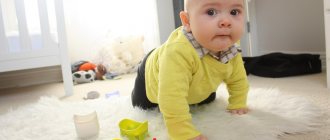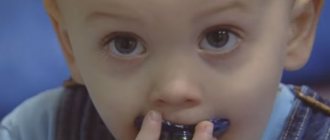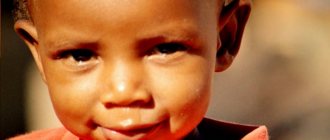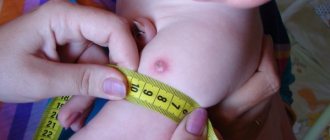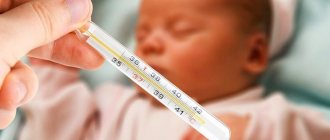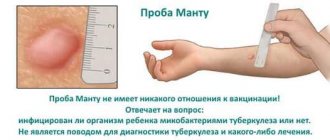Humanity has not yet come up with a more complete and healthy food for a baby than mother's milk. However, if the mother does not have milk or there is not enough milk, she has to decide how to accustom the baby to a bottle.
But even if the baby is breastfed, it may be necessary to give the baby liquid from a bottle. For example, if mom needs to go away. In addition, from the age of one month, you can give your baby water or special baby herbal teas to relieve colic in the intestines.
If there are no such problems, then for the first three months the child can not be given a bottle at all; mother’s milk will be enough for him to satisfy his needs for both food and drink.
But already at 3 months it makes sense to teach your child to drink water from a bottle. Since at this age children become more active and require more fluid.
Usually, it is not difficult to accustom an infant to a bottle. If the baby categorically refuses to drink liquid from the nipple, then there are certainly reasons for this refusal.
When is a pacifier needed?
Doctors strongly recommend using a pacifier, which can come to the rescue in a variety of situations. For example:
- it allows the newborn to satisfy his sucking reflex in cases where there is little or no breastfeeding;
- if the baby suffers from flatulence and finds it difficult to calm down;
- if the child does not fall asleep for a long time.
As you can see, the pacifier not only soothes, it also satisfies the sucking reflex. The latter, in turn, improves brain function and leads to the formation of “pleasure hormones” in the baby, which allows him to feel safe and sleep peacefully.
True, like any sedative, a pacifier must be chosen correctly and offered only at certain moments, taken away from the baby for the period when it is no longer needed.
An urgent need for a pacifier arises in cases where mothers have to give up long-term breastfeeding. If the baby is completely breastfed, his sucking reflex is fully satisfied. But if you take him away from his mother’s breast and offer him a pacifier instead, the newborn will probably feel the difference, and you are unlikely to be able to deceive the baby for a long time.
Is it worth training?
If the child is breastfed, then it will be possible to do without a bottle completely. As early as six months, you can start teaching your child to drink from a cup. If there is a need to give your child medicine or baby tea, you can do without a bottle. Liquid can be given to babies using a disposable syringe (without a needle, of course) or from a spoon. Older children should be offered a children's sippy cup.
But if a child receives formula, then it will not be possible to do without a bottle with a nipple; in this case, it is imperative to teach him to drink from it.
What to do if your baby won't take the pacifier
If your baby does not want to take the pacifier, there is no need to insist. In general, doctors strongly do not recommend giving a pacifier in the first days after birth; this should only be done in the third or fourth week. If the baby has already developed the skill of proper breastfeeding and is hungry, he may not perceive the pacifier, realizing that a nipple and a pacifier are not the same thing.
If your baby refuses to take the pacifier, try waiting another week or even a month. Try the training methods suggested below from time to time, but don’t insist if it doesn’t work right away.
Everything should happen at the right time, and then you will not have any problems.
To accustom your baby to a pacifier, sometimes you need to wait a few weeks or months.
Do you really need a bottle with a nipple?
A breastfed newborn should not be offered a bottle until one month of age. Trying to teach such a baby to drink from a nipple in some cases can even lead to breast refusal. You can give water to a baby in the first month of life using a pipette or a spoon. And besides mother's milk, he doesn't need anything else at this age.
Every month the volume of milk portion increases, and mother sometimes has to go away. To feed the baby, a spoon or pipette will no longer be enough, so a bottle with expressed milk comes to the rescue.
It is very important that the baby is already accustomed to this method of feeding. Because when it turns out that the child does not agree to suck anything other than the breast, turns away from the offered pacifier and cries, adults have to resort to various tricks so as not to leave the baby hungry.
How to train
Mom should try to teach the baby to suck a pacifier in any of the following ways.
- Try holding your newborn in the same position as when breastfeeding, but instead of a nipple, offer him to suck on a pacifier, having first dipped it in milk or formula. If your baby is not yet six months old, this method is quite effective.
- If your baby has already started teething, you need to offer him a pacifier instead of the usually used teething rings. The baby may well try to bite her with his teeth. To make it easier to accustom your baby to a pacifier, we recommend purchasing a rubber pacifier instead of a silicone or latex one.
- Artificial babies should be fed formula only from a bottle, never from a spoon. When the baby masters the pacifier on the bottle, he will take the pacifier for granted.
- If the baby has already had enough of his mother's milk and begins to fall asleep, do not let him just suckle at the breast like a pacifier. Offer him a pacifier at this moment, and he is unlikely to resist.
But what you definitely shouldn’t do is lubricate the pacifier not with milk or formula, but with something sweet - jam or honey. If you do this often, the baby may well develop diathesis or an allergy to sweets. In addition, his small teeth can be threatened by caries.
Why won't my baby take the bottle?
Dr. Komarovsky and other pediatricians cite the following reasons why a child may refuse to drink from a bottle:
- Unusual taste. If a baby is given something after breastfeeding that tastes different from breast milk, he will most likely refuse to drink it. Even adapted formulas have different tastes, so you will have to try different options until you find a formula that suits your child.
- Unusual temperature. A breastfed baby receives food at a certain temperature. Therefore, when offering a bottle to your child, you should ensure that the liquid is heated to a temperature of 36 -37 degrees.
- Uncomfortable nipple. Today, nipples for bottles of various shapes are available for sale. Therefore, it will not be difficult to choose the option that best suits your baby. The nipple may be too “tight”, meaning that too little fluid will flow through the hole. Or, on the contrary, if the hole in the nipple is too large, then the flow rate of fluid will be too high. All this can cause a child to refuse to take a bottle.
When is it good to give a pacifier?
The orthodontic pacifier is recommended by pediatricians for the correct formation of the jaw and teeth
This accessory will be useful to you in the following cases:
- If you are preparing your baby for bed. When a baby puts a pacifier in his mouth, it calms him, just like normal breastfeeding. In such cases, children usually fall asleep on their own and do not have to be rocked to sleep for a long time. But as soon as the pacifier has done its job and the baby falls asleep, carefully remove the pacifier from the mouth.
- If the newborn has gas. Sucking movements usually stimulate the intestines, as a result, gases will pass faster.
- If the baby is capricious at the moment when, for example, you are getting him ready for a walk, traveling with him on public transport, or sitting in line to see the doctor. In such cases, the pacifier distracts the child a little, and he begins to behave calmer. However, as soon as the baby becomes interested in something else, it is better to remove the pacifier.
In the first six months of a baby's life, the sucking reflex is very strong. From time to time the baby puts it in his mouth and tries to suck either his fist or his fingers, so for hygiene it is better to still give him a pacifier. The pacifier calms even hyperactive or excitable babies, so there is nothing wrong with having it in your arsenal until about a year old.
A few reasons against
Some parents, wanting their child not to disturb them, allow him to spend all his free time with a pacifier in his mouth. If your baby is already used to a pacifier, this is quite easy to achieve. But under no circumstances should you do this, and here’s why:
- Having started sucking a pacifier, the baby gradually “goes away” into this process, ceasing to look around and, accordingly, ceasing to explore the world that surrounds him. He becomes detached and even a little meaningless in his gaze. If you keep a child in this position for a long time, weeks and months on end, he begins to clearly lag behind his peers in his development;
- Children who are used to sucking a pacifier for a long time may well begin to speak later than others, or defects will appear in their speech. This has not been scientifically proven, but such a risk is clearly not worth discounting;
- easy to train, difficult to unlearn. Over time, when you come to your senses, weaning the baby from the usual accessory in the mouth will cost both of you a lot of nerves;
- Over time, sucking a pacifier for a long time can develop in a person a bad habit, a kind of “tic of obsessive movements.” A teenager will bite his nails, while an adult will constantly put the tip of a pencil or pen in his mouth, etc.
An extremely negative situation is when a young mother, having gone out for an hour-long walk with her baby, spends the entire hour talking to someone on the phone, thrusting a pacifier into her little son or daughter so that she “doesn’t interfere.” As a result, instead of watching other children or animals or communicating, the baby simply sits stupidly for the entire hour in the stroller, with a pacifier in his mouth, staring with a meaningless, detached gaze somewhere into space.
Is it necessary to teach - pros and cons?
Any pediatrician will offhand give examples from his practice when, due to the habit of a pacifier, a baby had problems with breastfeeding. The baby may either grasp the nipple incorrectly or swallow air during feeding, which leads to frequent regurgitation. The baby hasn’t even had enough to eat, but he’s already refusing to breastfeed and is getting tired.
In such situations, stopping the use of the pacifier can immediately improve the situation. And yet such cases are exceptions rather than the rule. Therefore, let’s try to list all the pros and cons of using a pacifier, because forewarned is, as they say, forearmed.
| pros | Minuses |
| The child masters not one, but two sucking skills at once. In one case he feeds, in the other he behaves calmly. While the mother's lactation is improving, the pacifier helps calm the baby and keep the situation under control. | You should not give a pacifier from birth, only in the third or fourth week. The baby first needs to learn the correct skill of sucking at the breast, and the pacifier can “confuse” him. As a result, the breast is not captured correctly, the nipple is not stimulated and even injured. This leads to deterioration of lactation and the baby’s refusal to feed. |
| “Artificial babies” get full faster, because drinking milk from a bottle is easier than sucking it from the mother’s breast. To satisfy the sucking reflex, these babies need a pacifier. | Without learning how to properly suck on their mother's breasts, children may not get enough to eat. Therefore, you need to accustom your baby to a pacifier only after he learns to eat. |
| Around the seventh month, it is already advisable to purchase an orthodontic pacifier, in which one of the sides is beveled. Such a pacifier will help to avoid abnormal bite and shape the jaw. | Sometimes children can develop an abnormal bite due to the pacifier. |
| The pacifier is an excellent sedative that can be used anywhere. With a pacifier, the baby sleeps longer. | You should always monitor the sterility of the nipple. Once it falls out of the mouth, it becomes a source of infection. Be prepared to give another pacifier during a walk - even if you lick the first one yourself, this will not save your child from infection. |
| If the baby constantly sucks his fingers or, having eaten, does not want to tear himself away from his mother’s breast, the pacifier will help switch him to another activity so that you can do other things. | The pacifier to some extent replaces physical contact with the mother. You shouldn’t rely too much on such a “substitution”; a pacifier will not replace your mother’s love. |
Why doesn't my baby want to drink from a bottle?
- Baby doesn't like the pacifier
It is desirable that the shape and size of the nipple match as much as possible with the mother's breast (round base and small tip). Parents can experiment with different nipples to find the perfect one for their baby - then he will start drinking milk from a bottle with pleasure. Read more about choosing a pacifier for your baby here.
- The child is not happy with the contents
A baby accustomed to the taste of breast milk may become capricious because he is offered pre-expressed milk at the wrong temperature - heating should be carefully monitored. If a mother introduces supplementary feeding due to insufficient lactation, the baby may also not like the taste of the formula, and because of this, he will refuse the bottle. In this case, you will have to purchase several types of mixtures to determine the best one to your taste. A pediatrician can help you choose.
- Milk flows too much or, conversely, flows out drop by drop
It is recommended to use a nipple that allows one drop of content per second - this is the optimal rate of milk flow to which the baby is accustomed. It is also necessary to monitor the position of the bottle when feeding: it should be held not vertically, but at a slight angle, while ensuring that the child grasps not only the tip of the nipple, but also its base.
How to choose
Children grow, and pacifiers must “grow” with them; different ages require more appropriately sized accessories. There are two types of nipples, and the baby may prefer one or the other - this can only be found out through experiment.
- A nipple with a classic round "papilla". Not the best choice, it is precisely this accessory that can disrupt the correct formation of the jaw and teeth in the future. By the age of 7 - 9 months, such a pacifier should be replaced with an orthodontic one.
- The orthodontic nipple has one side that is flatter and has a kind of bevel there. This pacifier fits better to the baby’s tongue; you just need to give it with the flat side down. The opposite side presses evenly on the palate. An orthodontic pacifier prevents air from being swallowed.
As for the material, it is better to buy products made of silicone or rubber. Latex is considered a more allergenic material.
Select the nipple shield:
- wide enough so that it does not fall into the baby’s mouth;
- with cutouts for the nose so that the baby can breathe freely;
- with a textured surface so that saliva does not accumulate and irritate the baby’s delicate skin.
Conclusion
There is no need to give up the pacifier; often it can really help you cope with your baby’s anxiety. But it should be used only for a limited time, getting rid of it at those moments when there is no longer a need for a pacifier.
It is impossible to give a baby a pacifier immediately after birth; it is necessary for him to develop the correct skill of sucking his mother's breast. Only after the baby begins to eat properly and be full, no earlier than three to four weeks, is it permissible to accustom him to the pacifier
Why does a child refuse a bottle: 5 main reasons
- The most common reason: you don't like the content. Very often it depends on the temperature. Children, despite their angelic expression, are, oddly enough, vindictive creatures. Once you don't please them, they will remember it for a long time. Therefore, the liquid should not exceed a temperature of 37 degrees, and it is better to generally offer water at room temperature.
- Unusual taste. If a child refuses only a bottle with formula, but accepts other liquids with a bang, most likely he does not like the taste or smell of the contents.
- Uncomfortable nipple. The bottle with the formula may have a nipple that is too tight, the baby is not able to suck out the contents, or, on the contrary, it may be too big, so he will choke and be afraid.
- Unusual surroundings. Children, especially in the early stages, are very sensitive and receptive. If more than a dozen eyes are looking at them, he will never show his skills and will not drink “to order.”
- Inappropriate mode. It happens that the child was offered a bottle for the first time at the wrong moment, when he was not at all in the mood for lunch.

